2018 Travel Blogging Summary! Year end review of my travels, Goth fashion blog outfits, Japan TV shows.
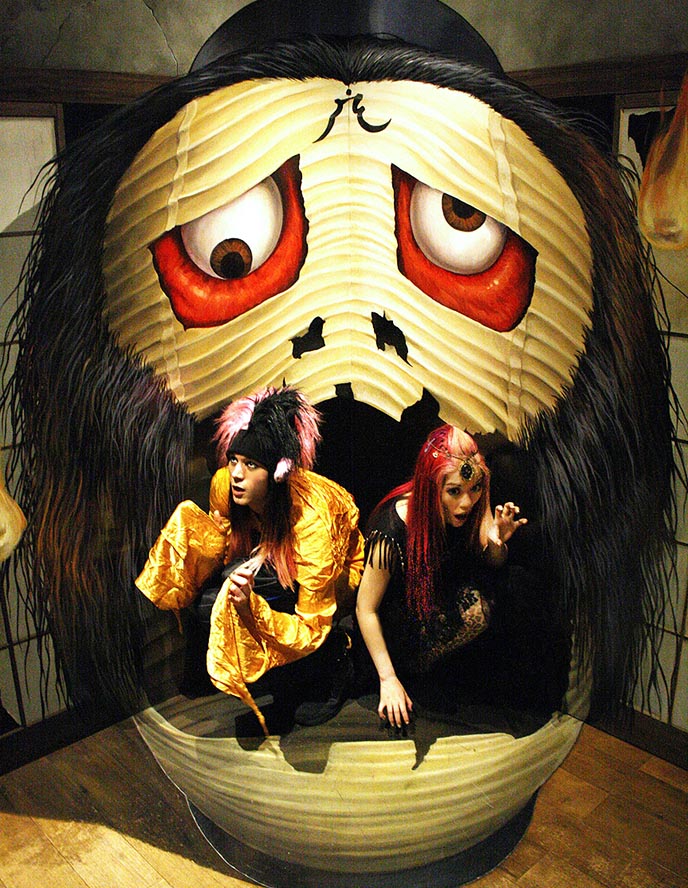
Yikes, where did the year go? Can’t believe it is the end of 2018 already! I’ve recently been swallowed up by work, so my apologies for the lack of blog updates – but we have a lot of exciting travels in store for you soon.
Right now, I’m having fun revisiting adventures for my new travel writing job for Touring Bird, a site by Google Area 120! I’m the insider expert for Tokyo, Hong Kong, and over a dozen other cities in Asia. I’ve been writing insider travel tips and city guides, of course with a focus on offbeat, hidden, alternative, and cute attractions — like the Tokyo Trick Art Museum above. Can’t wait to share more with you once my Touring Bird cities launch.

I have a lot to catch up on in the new year, including blogging about my recent adventures in Bangkok, Tokyo, Naoshima, and Hiroshima. And you can look forward to fabulous new travel stories soon… as Yukiro and I have a huge trip ahead in early 2019. Hint, cunning queens and cat worship! I’ll be hitting two other countries as well. Announcements soon, and you can always catch up on my daily life on Instagram @lacarmina.
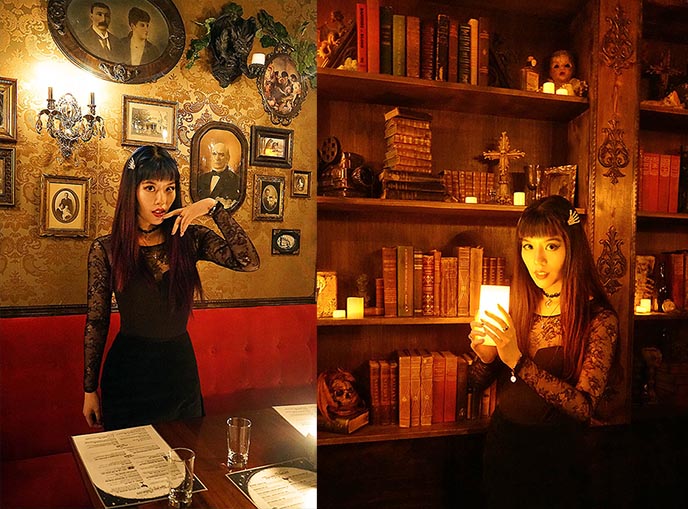
Let’s do a quick review of the past year, as we always do. I’ll also share some photos that hadn’t made it onto the blog.
Here are some snaps from an eerie new restaurant and bar that opened in Vancouver BC. Enclosed in a space with no windows, The Dark Manor fully immerses you into its haunted mansion theme. The upscale Victorian decor includes old ghostly portraits with eyes that follow you, and skulls and candles on a fireplace mantle.
This bar specializes in whiskey, and the craft cocktails have names like The Tight-Lipped Butler, The Baron’s End, and Danse Macabre. Each comes with a theatrical garnish: a “poisonous” vial, a cup of pills, a haunted house silhouette on egg white foam. The menu also has old-fashioned victuals like deviled eggs and pork medallions. If you have a Gothic disposition, you’ll love spending an evening here. (Wearing a lace bodysuit by UK Lingerie.)

I also descended under the sea to Vancouver’s Laurence and Chico Cafe. With fluffy hooded octopus chairs, this is one surreal place to grab an almond milk latte! You can also browse the couture on display, and munch on delicate pastries.
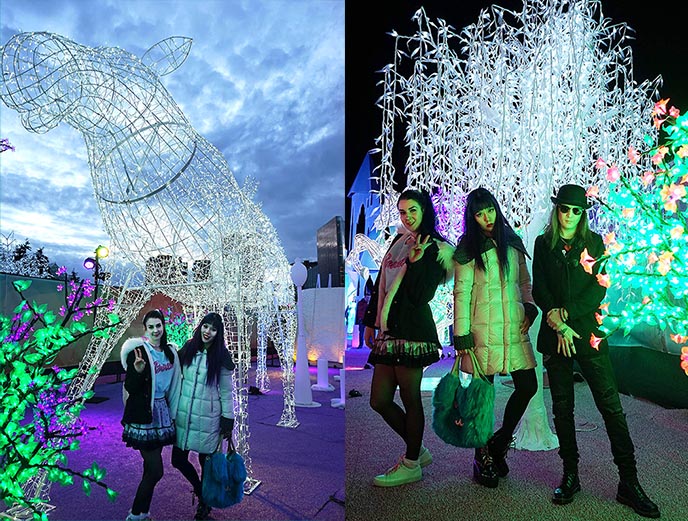
During Festivus season, my friends and I checked out the new Aurora Winter Festival in Vancouver. It’s a delight to drink hot mulled wine and pose amidst the Xmas lights displays.

I’m keeping warm thanks to my slim white puffer coat by Snowman New York, and leather leopard print gloves by Moschino.
You can see more outfits and images like these on my Instagram @lacarmina, as I now frequently update there with OOTDs.
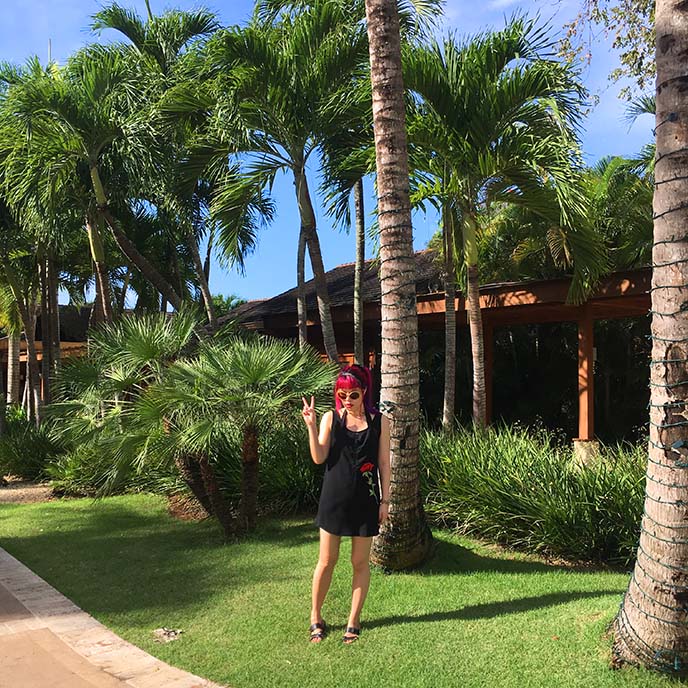
Now, let’s go back in time to the year that was! I’m grateful I was able to travel with various close friends this year. (Click the links to each destination to see all the images and stories.)
I started out January 2018 in the Dominican Republic, as a guest of the exquisite Casa de Campo resort. Still dreaming of the tropical food and white sand beach.
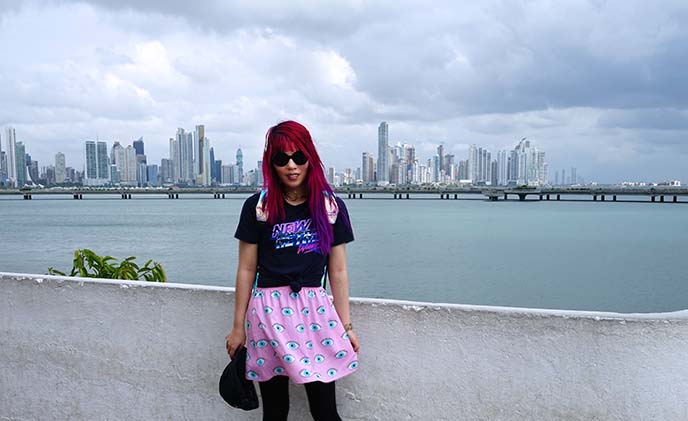
I did a quick stopover in Panama City, where I marveled at the futuristic skyline….
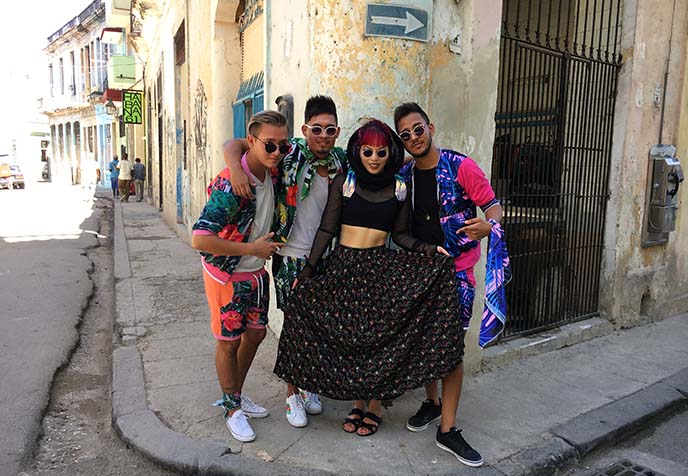
… before getting immersed in the retro culture of Havana, Cuba. I wrote about my Cuban travels for Movato Home, a national print magazine found in newsstands all over Canada. I’ve been writing regularly for them, so look for my stories there in each issue.
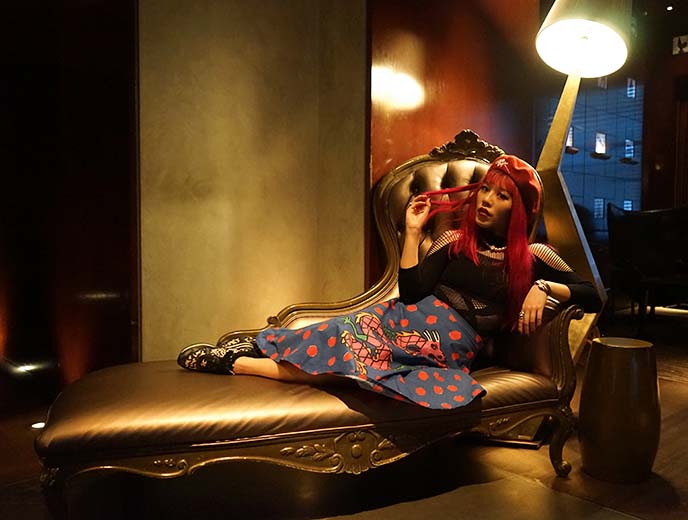
In the spring, I revisited San Francisco, CA with my “ghoul gang.” We shopped for Satanic statues, headbanged to synthwave, descended into Gothic clubs… just the usual shenanigans!
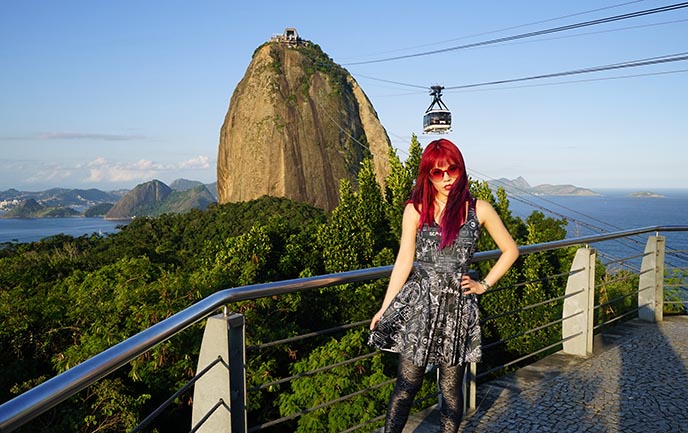
Next up, I fulfilled my goal to see South America. In a dream project with LATAM Airlines, I spent time in several major cities — incuding Rio de Janeiro and Sao Paulo in Brazil. (Here I am atop Sugarloaf Mountain.)

Don’t cry for me, Argentina… Buenos Aires was a blast. The culture and food lived up to their high reputation.
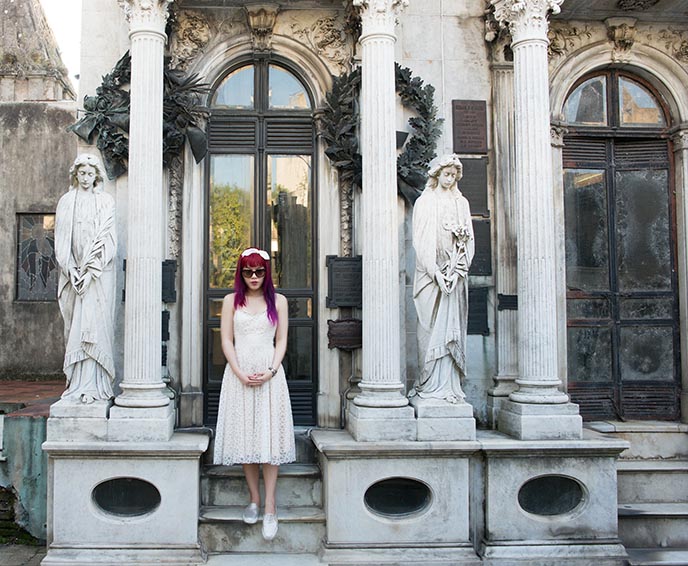
I haunted Recoleta Cemetery as the “woman in white,” and went to an Eva Peron (Evita) themed restaurant, among other explorations in BA.

Then, I flew on LATAM to Chile for the first time. I took a quick jaunt to Valparaiso, a wonderland of street art and a place you must visit.

I also explored Santiago, Chile – especially the hip LaStarria district. Random note: I get so many kind comments when I wear my Japanese post punk t-shirt!
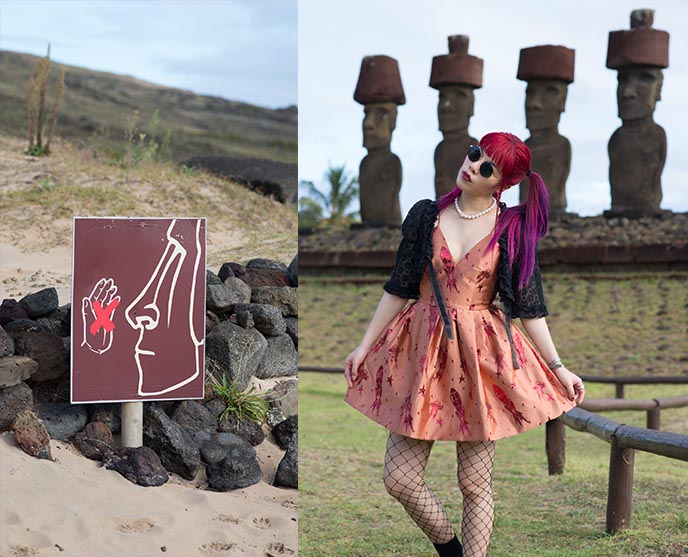
Words fail me when I recall my time on Easter Island, land of the stone-faced moai! Rapa Nui has been my ultimate bucket list destination since I was a kid. Still can’t believe I got to see the mysterious icons for myself, thanks to LATAM.

The island is one of the most remote in the world, and the landscapes are fascinating. If aliens ever came to Earth, I’m sure they landed on Easter Island.

After, my pirate Naomi and I plunged into working on a new travel TV show, with me as host. We shot it this fall in Tokyo, Japan – I’ll never grow tired of this city. It’s interesting how life has changed since launching La Carmina Blog, but Tokyo subcultures remain at the heart of everything.
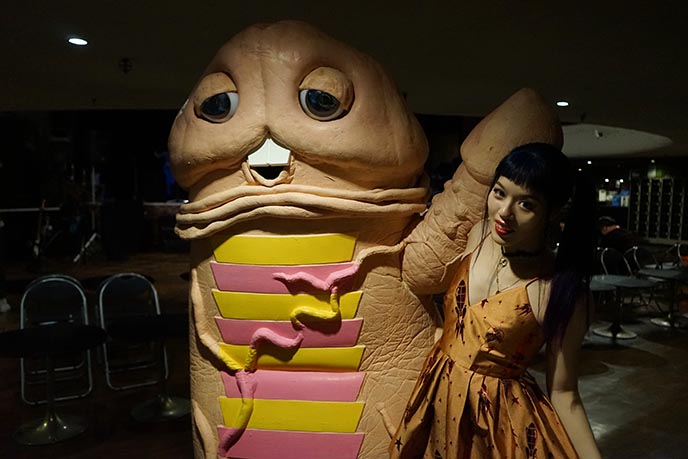
The travel television episode (Joko und Klaas, Duel around the World) aired in late fall. We were chuffed to hear your reactions to the crazy challenge and mascots! Read about it here and see TV clips if you missed it.
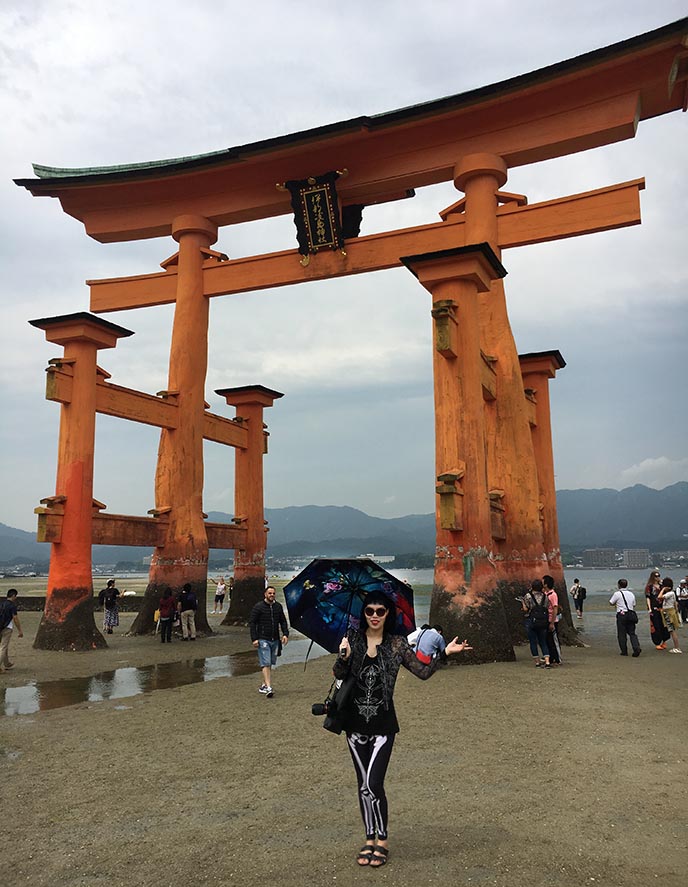
After finishing up the TV job, I traveled for the first time to Hiroshima with friends. Loved seeing Miyajima, the red gate, and visiting the Peace Memorial Museum.

We then hopped over to Bangkok (tons of stories to come), and Laos. The tranquil Luang Prabang charmed us with its warmth and food.
That’s 12 countries this year, if you count US and Canada – not bad! As I mentioned, there’s a massive trip coming up in February… so stay tuned for exciting visuals and stories.
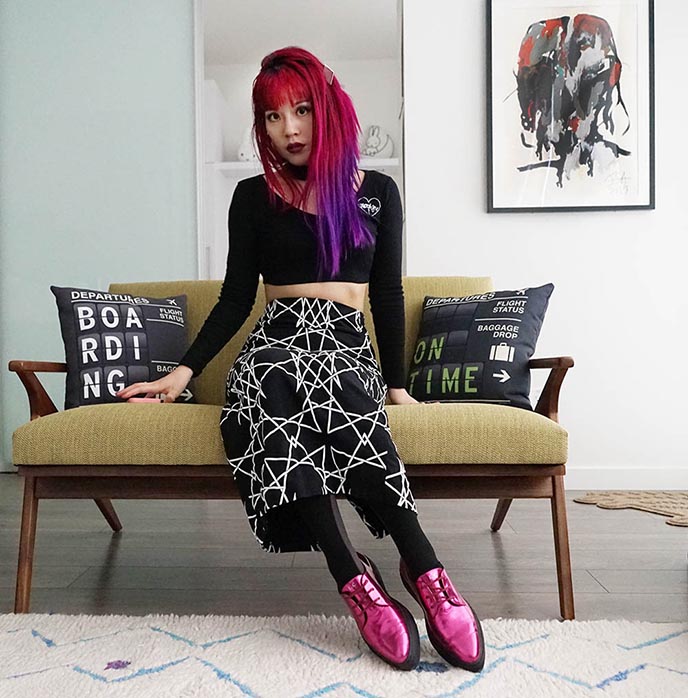
I’ll end with some outfit snaps from the past year. I’m wearing a Morph8ne top and Long Clothing skirt, while lounging on my Crate and Barrel love seat (you know I love mid century modern design). My pink shoes are for sale on my Depop if you’d like to snatch them up.

I had pink hair for the first half of 2018. Wearing a batwing top similar to this, an Erbert Chong bag and silver Irregular Choice ankle boots.

For my birthday party, I wore Print All Over Me skull black overalls and a Chinti & Parket striped top. (If you want to see more images from my minimalist mid-century modern apartment, click here.)

Time for a hair change! I’m going to stick with longer and darker for a while. My shoes are Jeffrey Campbell, similar to these boots. My three quarter length are floral Oroblu thigh highs from UK Tights.

Goth fashion, always. Wearing a faux fur coat and bone barrettes with a Killstar dress. It’s similar to this to this pentagram star straps dress.
I’m still selling my wardrobe on Depop @lacarmina – where I’m now a verified official seller! If you’d like anything from my personal collection of Goth / alt fashion and accessories, I’d be glad to send you a package. Simply see what I have listed here on Depop and contact me (gothiccarmina att gmail dotcom).

Leaving you with a final pic from Easter Island, wearing a House of Holland dress. Feeling gratitude for being able to see places like this with my own eyes.
Farewell, 2018 — here’s to a fulfilling and peaceful 2019! Happy New Year, everyone!
SHARE & COMMENT
Our crazy Japan travel TV show filming! Duell um die Welt, host Steven Gatjen in Tokyo, Joko und Klaas, Department H.
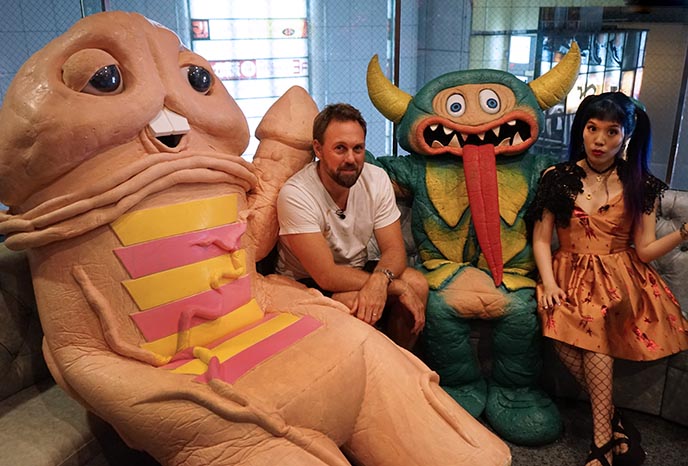
Uhh you may have recently seen La Carmina on German TV, with a giant peen… Ach du lieber!
Finally, we can reveal details of the crazy Japanese travel TV show we shot in September. As you may know, Naomi Rubin and I run a Pirates production company. We do local producing or “fixing” for travel television shows, in Tokyo and worldwide.
The Pirates have teamed up before with Joko und Klaas, the prime-time challenge show airing on Pro Sieben Germany. This time, “Das Duell um die Welt” (Duel around the World) featured celebrity guests… so we took presenter Steven Gätjen on a wild ride through Tokyo’s fetish underground!

It was fabulous to be on-camera again for Joko and Klaas’ program. As you’ll see, I delivered Steven Gätjen’s challenge, forced him to dress up in a pink studded suit, and introduced him to his bizarre band-members.
Keep reading to see the behind-the-scenes story of how we turned Steven into Ralf Acapulco, the schlager-industrial superstar singer… culminating in a hilarious performance at Department H, the alternative / S&M / latex / anything-goes party that remain the wildest in Tokyo.
❤ Wanna watch? I can’t post the full episode, but here are clips above and on Vimeo. ❤
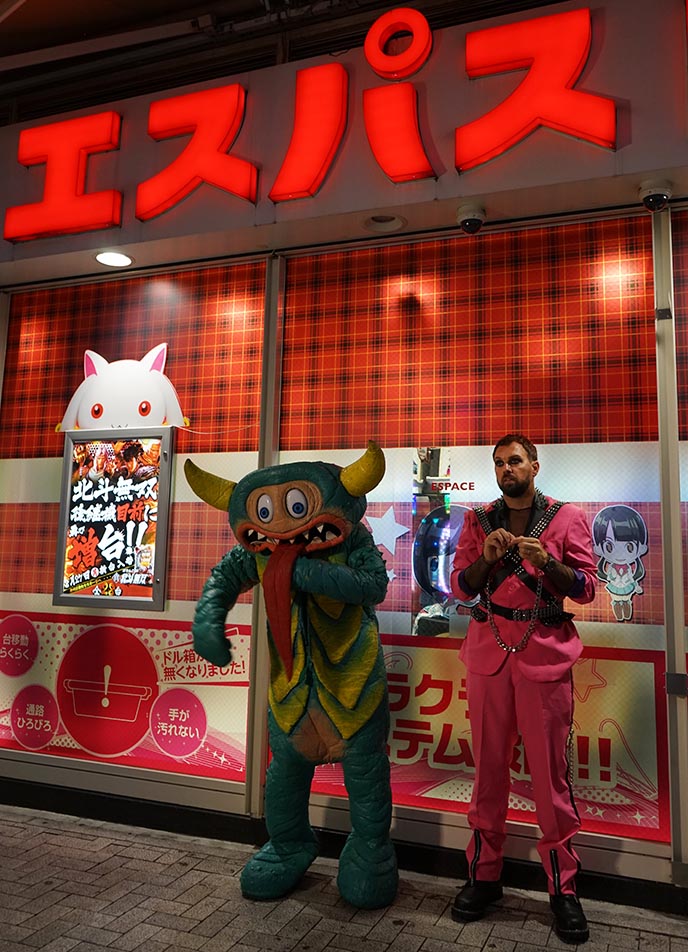
Naomi and I love working with the Joko gegen Klaas team, as they’re always keen to do something crazy for the TV show. The production process is a long one: we throw around ideas for the challenge, and then build a story and locations around it.
As fixers, the Pirates make the local arrangements in Japanese including securing permits and locations, casting extras, arranging costume and makeup, hiring a van driver, securing hotels, and any other logistics for a successful shoot.
(You may recall that we gave Klaas a bagelhead, and sewed Joko’s lips together for this show! We also worked with Palina Rojinski on a ProSieben travel shoot in Hong Kong, and Olli Schulz in a Box in Tokyo.)
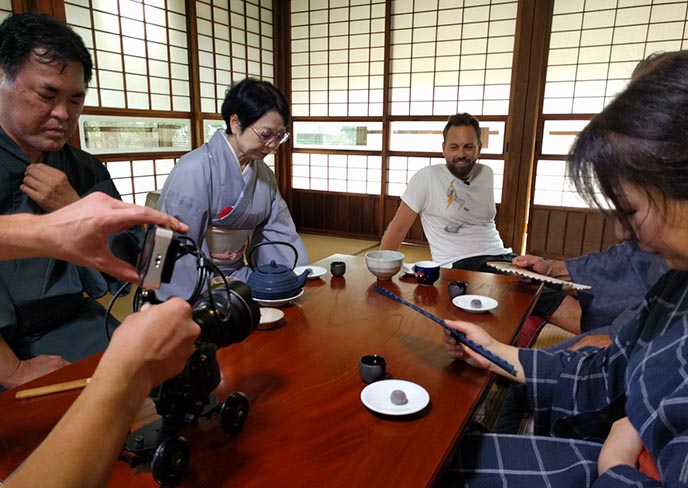
Steven’s adventure began in a Zen-like fashion. He sat down to a matcha tea ceremony, in a traditional tatami room that we rented.
The four people in kimono are extras that we hired… from the Japanese “rent a family” company! (Yes, you can hire someone to pretend to be your relative or significant other.) We previously rented the same lady to play a fake mother in Olli’s TV show.
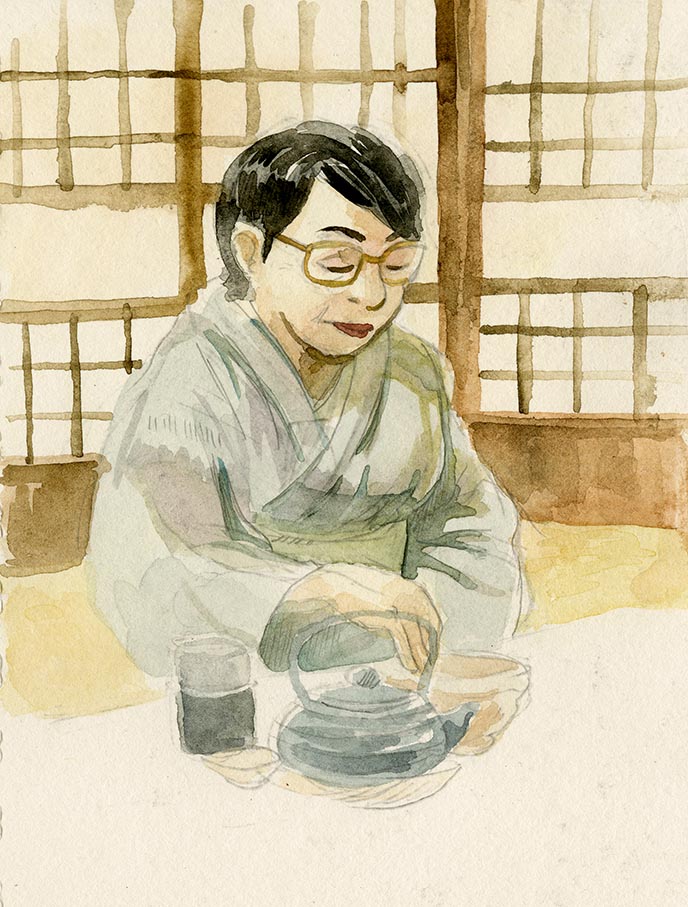
Naomi Rubin is an amazing Japanese-English translator who makes the shoot possible by communicating the director’s words to the cast. She is also a talented illustrator, and created the elegant watercolor above based on the tea house scene.
In this scene, Steven received a mysterious card with an address. This led him to the next location…

… A karaoke room, where wacky individuals were waiting for his arrival!
Steven Gätjen is lovely in person, with a gracious and positive attitude. We worked off a script, but had a good time ad-libbing during our scenes.
(My earrings are Alex Streeter, and dress House of Holland.)

Say hello to PicoPico. He makes astonishing full body costumes of monsters and strange creatures. We hired him to be on the show, wearing his original green Becos costume.

While we waited for our scene, Pico Pico and I did karaoke… why not, we were in Karaoke Kan Shibuya after all!
What’s the deal with the blacklight space dolphins on the walls of the karaoke booth? Again… why not! (When you choose a song and it begins, the room lights up with a disco ball and neon lights.)

Pico Pico selected a Power Rangers tune to belt out. Love the spaceship background of the karaoke video.

Yours truly stuck to disco. We did a YMCA duet, of course with the appropriate hand motions!
(If the monster costume looks familiar, it’s because he was also in the French travel TV show I did years back, with Antoine de Caunes for Canal Plus.)

And then, a giant penis arrived… Welcome, Mr Peen! He was so big that he could hardly fit through the doors, no joke.
This phallic character, known as Gachachin, often pops up at Department H and once appeared at Kanamara Matsuri, the Penis Festival in Japan. The old costume got a bit… rotten… so the creator whipped up a fresh and bigger one in just three days.

As you can see, it takes two men to deal with the massive Mr Peen! When Sasano is inside, he can shuffle around and go turgid or flaccid. Check out the vein-y detailing on the foam body, and the arm appendage.

PicoPico also got inside his suit (he can see out of the mesh mouth area).
Naomi arranged for us to shoot in at Karaoke Kan Shibuya, in the exact same glass booth featured in the Lost in Translation movie by Sofia Coppola.
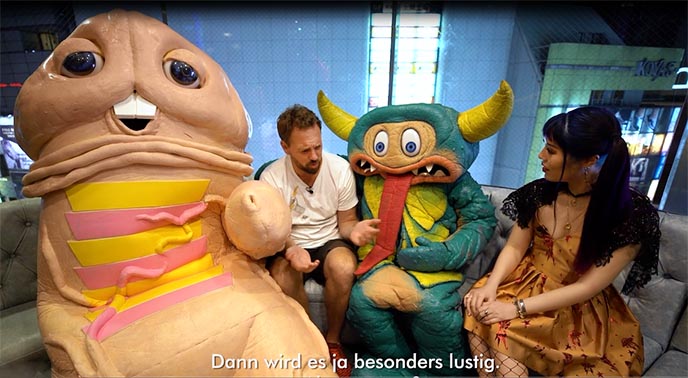
Here’s a screenshot from the scene we shot together. I introduced myself as Steven Gaetjen’s challenge-meister for Tokyo.
I’m sitting in the same place as Scarlett Johansson in the film, but unlike her pink wig, my hair color is real. (My cape is by Pheren Couture)

I presented Steven with his Tokyo challenge. He had to sing live on stage, at a wild party with hundreds of people watching… with Picopico and Mr Peen as his band members!

Steven Gaetjen had to perform a song that mixed schlager (cheesy, upbeat German music) with industrial (Rammstein-esque headbanging). He had to dress the part, hence this pink-studded costume that I declared was “so fash.”
To add insult to injury, I made Steven take part in a nonsensical interview with a Japanese news crew. Our friends Miki, Ken and Yugo did a fantastic job acting as the host and camera crew for this segment.

We hired makeup and hair artist Tomomi Tokuda to give Steven this edgy look. She nailed it, and was a pleasure to work with.
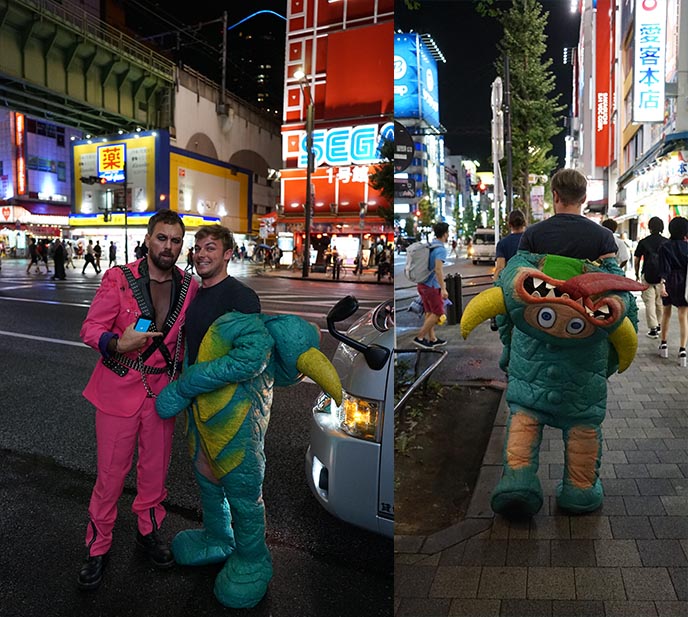
Travel TV shows always need a ton of B-roll footage, so we headed to Akihabara to do a montage of Steven and the monster. PicoPico couldn’t be there for that scene… so someone else literally stepped into his big shoes!

Akiba, the otaku and anime “electric town,” made the perfect setting for these funny scenes. Above, the monster insists on taking a selfie with Steven, who is not amused.

Strolling through Tokyo, dressed ridiculous and shooting a TV show… just a typical day in the life of La Carmina and the Pirates.
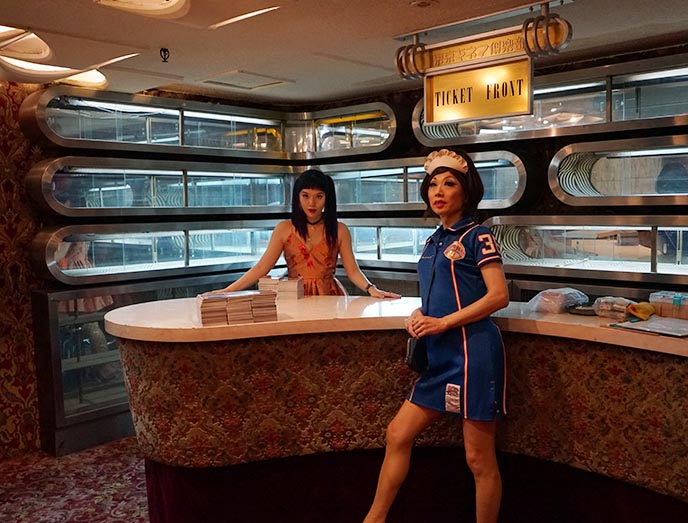
Finally, Steven arrived at the most insane party in Tokyo, if not the universe: Department H. (Keep scrolling for photos, and you’ll see why.)
Organizer and mistress of ceremonies, Gogh, generously let us film here many times.

The Dept H party starts at midnight, and takes place the first Saturday of each month. However, the crew got here early to set up and rehearse the performance.
We put up a poster featuring Steven’s flamboyant alter ego, Ralf Acapulco, who would be performing “Sushi of Love” live on stage.

“Itai, itai… painful!” Looks like Mr Peen is made to be a drummer. He even has a hole for his drum stick!

Time to rehearse, with the instruments that we rented. I can’t stop laughing every time I see Mr Peen banging on the cymbals.
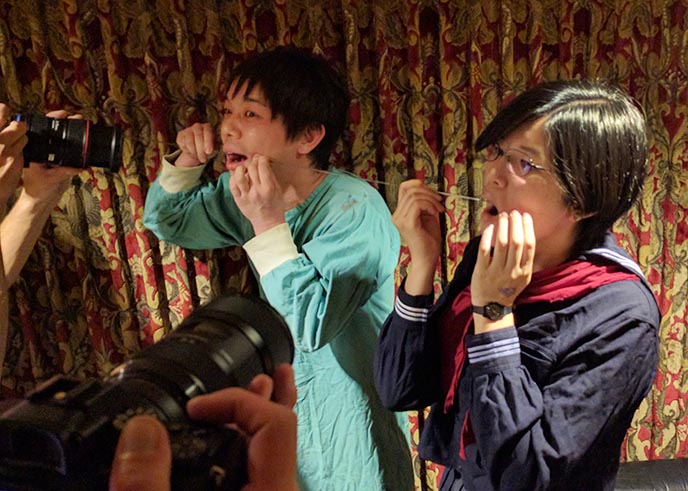
As you can see in the video clips, I took Steven to meet his keyboard players. These three are the Gokiburi crew… and they shocked him by sticking a long skewer through their cheeks, like a human shish kebab.

No Photoshop here. These regular-looking folk gleefully stuck a long metal needle through their jowls, connecting themselves together. Gotta love the creativity of Japanese body modifications.

Naomi shows them how to choreograph their headbanging and hand gestures during the live performance. (In this rehearsal photo, they aren’t yet human-centipeded together.)

Looks like somebody is happy to see me. P size wa?!
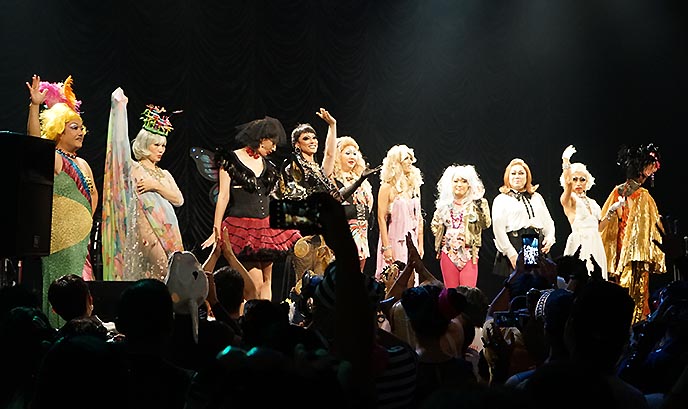
Department H takes place at Uguisidani’s Kinema Club. The regular club night has been raging since the 1990s, and is still going strong. The event includes a drag queen show…

… and weird, racy performances such as this monster wrestling match.
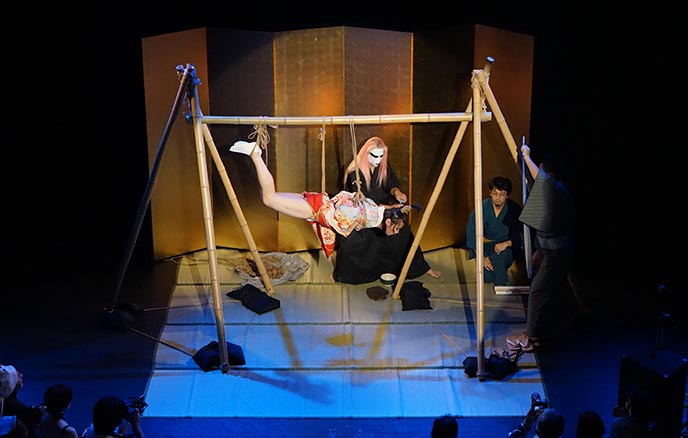
Hajime Kinoko, shibari artist, tied up a victim on stage with rope. The person’s hair was then dipped in ink, and used to paint calligraphy on a scroll.
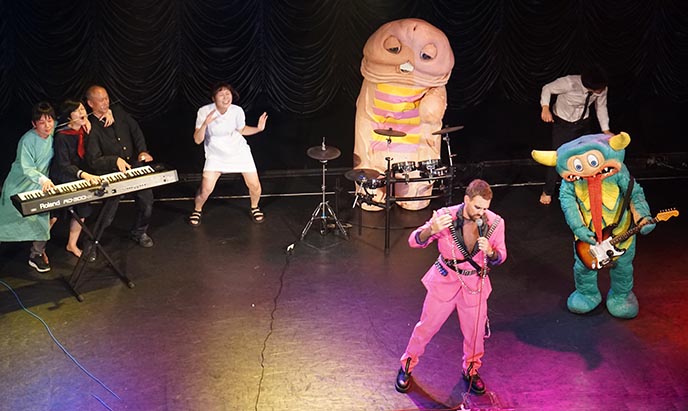
And then, “Ralf Acapulco” took the stage! The contrast between the bright schlager and scream-and-groan Industrial rock made for a hilarious performance.
(Watch some clips from the TV show below, as well as extras on my Instagram video.)
Danke everyone for watching me on Joko und Klaas: Duell um die Welt, Tokyo episode! Take a moment to see what we got up to in the video. I hope our surreal monster dance makes you laugh.
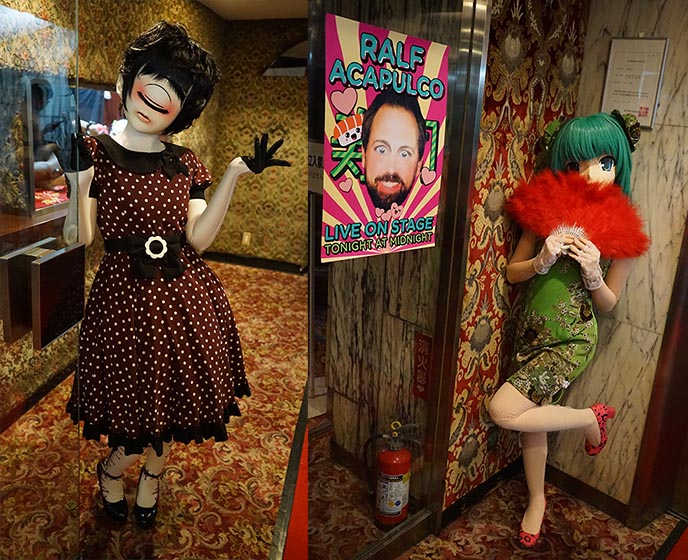
I’ll leave you with mind-bending photos from Department H nightclub. The partygoers wear the most bizarre outfits you’ll see on the galaxy. At Dept H, you can be whoever you want to be — whether it’s a one-eyed dolly, or a green haired lady of the night.
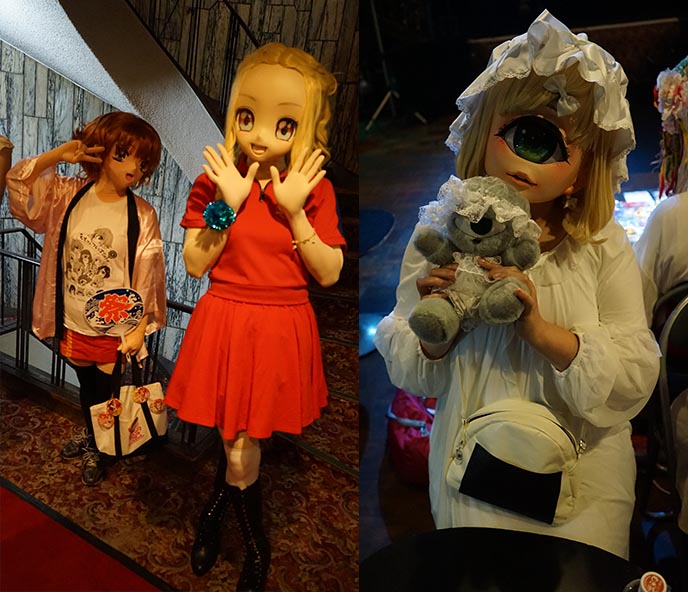
You’ll see a lot of anime kigurumi, or dollers, at Department H. Typically handmade, these are full-body suits that include giant masks with big eyes. The effect is a bit cute, a bit creepy… a real-life anime or manga character come to life in three dimensions.
(Click below to see more photos.)
 LA CARMINA
LA CARMINA






